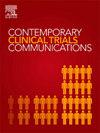生仙祛瘀汤治疗射血分数降低和轻度降低心衰(SHINE-HF):多中心随机对照试验的理论基础和设计
IF 1.4
Q4 MEDICINE, RESEARCH & EXPERIMENTAL
引用次数: 0
摘要
背景:尽管当代指导药物治疗(GDMT)对心力衰竭(HF)伴射血分数降低(HFrEF)和心力衰竭伴射血分数轻度降低(HFmrEF)已被证明可显著改善预后,但这些患者仍面临相当大的残留风险,其生活质量(QoL)仍然严重受损。生仙祛瘀汤是临床广泛使用的一种治疗心衰的补充替代药物。然而,目前没有强有力的证据支持其对HFrEF和HFmrEF的疗效,其潜在的不良反应尚未完全阐明。方法将慢性心力衰竭、纽约心脏协会(NYHA) II-IV级症状、血浆利钠肽水平升高、左心室射血分数(LVEF)≤50%的患者纳入生仙去瘀汤治疗降低和轻度降低射血分数(shin -HF)心力衰竭试验。符合条件的患者进入磨合期,随后按1:1的比例随机分配至双盲治疗,使用30毫升SXQY或30毫升安慰剂,每天两次。主要终点是第12周堪萨斯城心肌病问卷临床总结评分(KCCQ-CSS)的基线变化。主要次要终点包括第12周中医证候评分量表(TCMSSS)和6分钟步行测试(6MWT)距离较基线的变化。此外,还将进行安全分析。结论shine - hf将决定SXQY对HFrEF和HFmrEF患者报告预后(pro)和症状负担的影响。这将阐明SXQY作为一种改善HFrEF和HFmrEF患者生活质量的新治疗选择的潜力。本文章由计算机程序翻译,如有差异,请以英文原文为准。
SHengXIaN-QuYu DEcoction in the Treatment of Heart Failure with Reduced and Mildly-Reduced Ejection Fraction (SHINE-HF): rationale and design for a multicenter randomized controlled trial
Background
Although contemporary guideline-directed medical therapy (GDMT) for heart failure (HF) with reduced ejection fraction (HFrEF) and heart failure with mildly-reduced ejection fraction (HFmrEF) has been shown to significantly improve prognosis, patients with these conditions still face considerable residual risk, and their quality of life (QoL) remains severely compromised. ShengXian-QuYu (SXQY) Decoction is a widely prescribed complementary and alternative medicine (CAM) therapy for HF in clinical practice. However, there is currently no robust evidence supporting its efficacy in HFrEF and HFmrEF, and its potential adverse effects have yet to be fully elucidated.
Methods
Patients with chronic HF, New York Heart Association (NYHA) class II–IV symptoms, elevated plasma natriuretic peptide levels, and a left ventricular ejection fraction (LVEF) of ≤50 % were enrolled in the ShengXian-QuYu Decoction in the Treatment of Heart Failure with Reduced and mildly reduced Ejection Fraction (SHINE-HF) trial. Patients eligibility entered a run-in period, followed by randomization in a 1:1 ratio to double-blind treatment with either 30 ml of SXQY or 30 ml of placebo, administered twice daily. The primary endpoint was the change from baseline in the Kansas City Cardiomyopathy Questionnaire Clinical Summary Score (KCCQ-CSS) at week 12. Key secondary endpoints included the change from baseline in the Traditional Chinese Medicine Syndrome Score Scale (TCMSSS) and the 6-min walk test (6MWT) distance at week 12. Additionally, a safety analysis will be conducted.
Conclusion
SHINE-HF will determine the effects of SXQY on patient-reported outcomes (PROs) and symptom burden in patients with HFrEF and HFmrEF. This will shed light on the potential of SXQY as a novel treatment option in improving QoL of patients with HFrEF and HFmrEF.
求助全文
通过发布文献求助,成功后即可免费获取论文全文。
去求助
来源期刊

Contemporary Clinical Trials Communications
Pharmacology, Toxicology and Pharmaceutics-Pharmacology
CiteScore
2.70
自引率
6.70%
发文量
146
审稿时长
20 weeks
期刊介绍:
Contemporary Clinical Trials Communications is an international peer reviewed open access journal that publishes articles pertaining to all aspects of clinical trials, including, but not limited to, design, conduct, analysis, regulation and ethics. Manuscripts submitted should appeal to a readership drawn from a wide range of disciplines including medicine, life science, pharmaceutical science, biostatistics, epidemiology, computer science, management science, behavioral science, and bioethics. Contemporary Clinical Trials Communications is unique in that it is outside the confines of disease specifications, and it strives to increase the transparency of medical research and reduce publication bias by publishing scientifically valid original research findings irrespective of their perceived importance, significance or impact. Both randomized and non-randomized trials are within the scope of the Journal. Some common topics include trial design rationale and methods, operational methodologies and challenges, and positive and negative trial results. In addition to original research, the Journal also welcomes other types of communications including, but are not limited to, methodology reviews, perspectives and discussions. Through timely dissemination of advances in clinical trials, the goal of Contemporary Clinical Trials Communications is to serve as a platform to enhance the communication and collaboration within the global clinical trials community that ultimately advances this field of research for the benefit of patients.
 求助内容:
求助内容: 应助结果提醒方式:
应助结果提醒方式:


